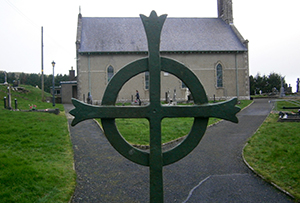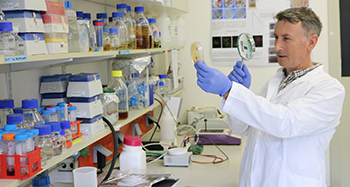The ‘healing clay’ of Boho
Published in Issue 2 (March/April 2019), News, Volume 27From superstition to Streptomyces.
By Eugene Dunphy

On the morning of Sunday 2 January 1842, two unnamed young men set out on a mission. A relative of one suffered from tuberculosis (TB) and had subsequently contracted scrofula, a side-effect of TB that caused disfiguring abcesses in the neck of the unfortunate sufferer. Hoping to find a cure, the two friends—one from Beleek, Co. Fermanagh, the other from Ballintra, Co. Donegal—went in search of the ‘healing clay’ which was to be found, they were informed, on the grave of a deceased Catholic priest in the graveyard of the Sacred Heart Church in Boho (pronounced ‘Bo’), about ten miles outside Enniskillen. Arriving in the village of Church Hill, some twelve miles from Boho, they stopped to ask for directions at St Catherine’s, the home of 33-year-old George Rogers. The unsuspecting travellers were unaware that Rogers was an ardent Protestant, one who had little time for superstition and who firmly believed that Catholics belonged to what he described as ‘the apostate church of Rome’. Having supplied the men with the required information and set them on the right road, Rogers spent a portion of the Sabbath Day writing a letter to the Enniskillen Chronicle and Erne Packet in which he criticised the fatigued-looking apostates for going to a churchyard to engage in ‘distressing idolatry’ at the grave of ‘an idolized demoralized old priest called Magar, a well known character in Innismacsaint’.
The old priest to whom Rogers alluded was in fact Fermanagh-born Fr James McGirr (1745–1815). Shortly after his ordination in 1770 he was appointed to the parish of Inis Muighe Samh (Innismacsaint) in the diocese of Clogher. While living in Derrygonnelly, he established a reputation as a ‘curing priest’ and was known to offer his healing gifts to people of all faiths. It is said that he once told his concerned parishioners, ‘After I die, the clay that covers me will cure anything that I cured when I was with you’. The clay was usually collected in rags of cotton or linen. It appears that keeping it wrapped in such material helped to trap and preserve the clay’s healing qualities better than metal or delph containers. These little curing packages were then carefully placed under the pillow of the patient and a series of prayers recited. After a few days, the soil was returned to the grave. Commenting on the intended mission of the two friends from Beleek and Ballintra, George Rogers remarked, ‘This journey when completed will cost the unfortunate dupes ninety-six miles travel as it is a notorious fact that the cure is not completed until the holy thing is restored from whence it came’.

It now seems that Rogers was misguided in criticising the wayfaring ‘dupes’. Indeed, current research suggests that the soil around Fr James McGirr’s grave could revolutionise the future of medicine. ‘There’s always something behind these traditions or they wouldn’t be going on so long’, said Dr Gerry Quinn, former resident of Fermanagh and part of an international group of researchers at Swansea University Medical School. Dr Quinn and fellow researchers Paul Dyson, Ibrahim Banat, Alyaa Abdelhameed, Matthew Hitchings, Liam Thomas, Luciana Terra, Salvatore Gazze, Paul Facey, Lewis Francis and Dusica Vujaklija are the constituent parts of a crack team of scientists who have discovered that the alkaline soil in Boho contains bacteria or Streptomyces which can target and combat superbugs. Since the World Health Organisation has warned that superbugs could be responsible for the deaths of 1.3 million people in Europe by 2050, the team’s work is not only innovative but timely. ‘This new strain of bacteria is effective against four of the top six pathogens that are resistant to antibiotics, including MRSA,’ said Paul Dyson. ‘Our discovery is an important step forward in the fight against antibiotic resistance.’
As for George Rogers, on Sunday 5 November 1843 he managed to persuade his Catholic servant, Mr Snowe, to attend Benmore church, where he converted to Protestantism. Rogers died at St Catherine’s of an ‘inflammation of the chest’ on 16 November 1848. He was 39. It is not known whether the scrofula sufferer made a full recovery. Given the curative properties of Fr McGirr’s Boho soil, perhaps he did.
Eugene Dunphy is a music teacher and local historian based in Belfast.
FURTHER READING
P. Logan, The holy wells of Ireland (London, 1980).
‘Superstition Unrivalled’, Enniskillen Chronicle and Erne Packet (6 January 1842).
L. Terra, P.J. Dyson, M.D. Hitchings et al., ‘A novel alkaliphilic Streptomyces inhibits ESKAPE pathogens’, Frontiers of Microbiology (2018).
















